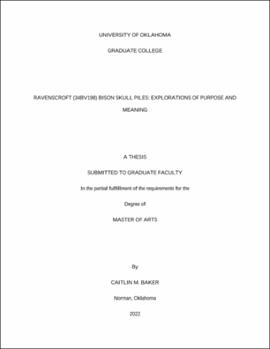| dc.contributor.advisor | Bement, Leland | |
| dc.contributor.author | Baker, Caitlin | |
| dc.date.accessioned | 2022-12-09T20:56:23Z | |
| dc.date.available | 2022-12-09T20:56:23Z | |
| dc.date.issued | 2022-12-16 | |
| dc.identifier.uri | https://hdl.handle.net/11244/336910 | |
| dc.description.abstract | Ravenscroft is a late Paleoindian arroyo bison kill located along a tributary of the Canadian River named Bull Creek in the Oklahoma Panhandle. Multiple field seasons eventually identified two stacks of bison skulls at the mouth of the arroyo. All but one of the skulls were missing mandibles. None of the skulls exhibited bashing, suggesting they were not set aside for brain removal. Two arroyos were identified, labeled RAV I and RAV II. Further complicating interpretations of purpose were the returned radiocarbon dates. Included in the piles were skulls representing at least three of the five kill events. These skulls span over 300 years of history, implying a much more complex purpose than subsistence or stockpiling. Through further analysis and comparison with other occurrences of stacked skulls worldwide, this thesis explores the potentially ritualistic aspects of this site and attempts to explain the purpose of the stacked skulls. | en_US |
| dc.language | en_US | en_US |
| dc.subject | Archaeology | en_US |
| dc.subject | Ritual | en_US |
| dc.subject | Paleoindian | en_US |
| dc.subject | Bison | en_US |
| dc.title | Ravenscroft (34BV198) Bison Skull Piles: Explorations of Purpose and Meaning | en_US |
| dc.contributor.committeeMember | Randall, Asa | |
| dc.contributor.committeeMember | Pitblado, Bonnie | |
| dc.date.manuscript | 2022-12-09 | |
| dc.thesis.degree | Master of Arts | en_US |
| ou.group | Dodge Family College of Arts and Sciences::Department of Anthropology | en_US |
| shareok.orcid | 0000-0003-3314-9429 | en_US |
